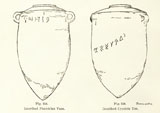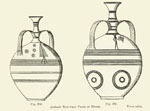Previous First Next
SALAMIS IN THE ISLAND OF CYPRUS.
BY ALEXANDER PALMA DI CESNOLÀ, F.S.A.,
page 113
CHAPTER XXI.
TERRA-COTTA.
Continued.
URNS - VASES—AMPHORA - ARCHAIC ARYBALLI—FUMIGATORS—HAND- OR FOOT-WARMERS—STRAINERS—POTS— LATER ARYBALLI—MISCELLANEOUS—ROMAN, ETC.
 HE number of these objects in this collection is very considerable indeed, not fewer than four thousand pieces in all. These comprise amphorae of various sizes, from about four feet high to the smallest examples, and of various origins, being Phœnician, Cypriote, and Greek; some of them bear inscriptions in one or other of these languages respectively. Among the vases of this class, more than two hundred exhibit beautiful patterns painted on their surfaces, including birds, bulls, and other creatures; many of those are extremely precious works, some of them are believed to be unique as to the decorations they bear and as to their origin; it is supposed that these remarkable instances are pure Phœnician; their decorations agree in general respects with those of other vessels to which the name of the Phœnician nation has been given. The accompanying illustration represents a Phœnician vase of considerable dimensions (fig. 258). It contains an inscription of five letters in the Phœnician language, of which, according to M. Piérides, who has examined it, the Hebrew transliteration is the following— Baal-Hammon; i.e., "Baal Solaris, or Baal the Sun".1 HE number of these objects in this collection is very considerable indeed, not fewer than four thousand pieces in all. These comprise amphorae of various sizes, from about four feet high to the smallest examples, and of various origins, being Phœnician, Cypriote, and Greek; some of them bear inscriptions in one or other of these languages respectively. Among the vases of this class, more than two hundred exhibit beautiful patterns painted on their surfaces, including birds, bulls, and other creatures; many of those are extremely precious works, some of them are believed to be unique as to the decorations they bear and as to their origin; it is supposed that these remarkable instances are pure Phœnician; their decorations agree in general respects with those of other vessels to which the name of the Phœnician nation has been given. The accompanying illustration represents a Phœnician vase of considerable dimensions (fig. 258). It contains an inscription of five letters in the Phœnician language, of which, according to M. Piérides, who has examined it, the Hebrew transliteration is the following— Baal-Hammon; i.e., "Baal Solaris, or Baal the Sun".1  One of the workmen whom I had employed in my excavations found a conical urn or One of the workmen whom I had employed in my excavations found a conical urn or  vase, similar in shape to the foregoing specimen, in a tomb to the south-west of Larnaca, and outside the walls of the ancient city of Kitium. The vase is of the ordinary terra-cotta of the island (fig. 258) and bears the Cypriote inscription now engraved in the accompanying illustration. On being informed of this discovery I proceeded to the spot, and found that the tomb was about nineteen feet and a half below the surface of the ground. It had been constructed of large stones, cemented together, as they were laid on the earth, with lime. It had an oval shape, except at the bottom; and was six feet nine inches deep,, and little more than six feet wide. The entrance had been closed with a square slab of stone, roughly hewn. The earth, sodden with the rain, which had percolated for ages through the defective cementing of the roofing stones, covered the floor to the 1 See Gesenius, Script. Phoenic. extent of more than eight inches; but as there was no sarcophagus in the tomb, and the body which the tomb had received was laid on the earth, I could find no other vestige of humanity than a small piece of bone which perhaps belonged to the head of a child. No sooner did this relic come into contact with the air than it crumbled away into dust. The inscription upon this vase is, I am told by Dr. Birch, to whom I have submitted it, of a doubtful signification. It appears to read:— mi . e . o . sa . ti . ja . ta . But the first two characters on the right are uncertain. It is evidently the genitive case of a proper name prefixed to the verb emi, I am, or I belong to; and may perhaps be read " I belong to Tajatisas," or " Tathasus". A vase very similar to this in general shape has two handles on the shoulder. For a valuable notice of the urns and fictilia which occur in the island, I may refer to the paper " On the Different Styles of Pottery found in Ancient Tombs in the Island of Cyprus", by Thomas Sand with, Esq., H. B. vase, similar in shape to the foregoing specimen, in a tomb to the south-west of Larnaca, and outside the walls of the ancient city of Kitium. The vase is of the ordinary terra-cotta of the island (fig. 258) and bears the Cypriote inscription now engraved in the accompanying illustration. On being informed of this discovery I proceeded to the spot, and found that the tomb was about nineteen feet and a half below the surface of the ground. It had been constructed of large stones, cemented together, as they were laid on the earth, with lime. It had an oval shape, except at the bottom; and was six feet nine inches deep,, and little more than six feet wide. The entrance had been closed with a square slab of stone, roughly hewn. The earth, sodden with the rain, which had percolated for ages through the defective cementing of the roofing stones, covered the floor to the 1 See Gesenius, Script. Phoenic. extent of more than eight inches; but as there was no sarcophagus in the tomb, and the body which the tomb had received was laid on the earth, I could find no other vestige of humanity than a small piece of bone which perhaps belonged to the head of a child. No sooner did this relic come into contact with the air than it crumbled away into dust. The inscription upon this vase is, I am told by Dr. Birch, to whom I have submitted it, of a doubtful signification. It appears to read:— mi . e . o . sa . ti . ja . ta . But the first two characters on the right are uncertain. It is evidently the genitive case of a proper name prefixed to the verb emi, I am, or I belong to; and may perhaps be read " I belong to Tajatisas," or " Tathasus". A vase very similar to this in general shape has two handles on the shoulder. For a valuable notice of the urns and fictilia which occur in the island, I may refer to the paper " On the Different Styles of Pottery found in Ancient Tombs in the Island of Cyprus", by Thomas Sand with, Esq., H. B.  M. Vice Consul. Archǽologia, vol. xlv, 1877. Two red ware vases deserve especial mention, because they are unique in exhibiting figures painted in black on their bodies. On .one of these (figs. 260, 262) is a standing owl, or swan, and opposite to it a tree of the M. Vice Consul. Archǽologia, vol. xlv, 1877. Two red ware vases deserve especial mention, because they are unique in exhibiting figures painted in black on their bodies. On .one of these (figs. 260, 262) is a standing owl, or swan, and opposite to it a tree of the sacred or "Horn" kind, the emblematic palm, or date tree, which was found significant over many regions in Asia, and has been frequently recognised in Assyrian remains, even on the breastplates of the kings in Chaldea, Egypt, India, and China. What may be a reminiscence of the "Horn" is often seen to this day in Turkey carpets. The Greek anthemion, or honeysuckle ornament, has been referred to as the Greek variety of this symbol degraded into an ornament, and with no other significance than that which is due to a lovely combination of harmonic lines. On the other vase (fig. 261) are the figures of two men, sacred or "Horn" kind, the emblematic palm, or date tree, which was found significant over many regions in Asia, and has been frequently recognised in Assyrian remains, even on the breastplates of the kings in Chaldea, Egypt, India, and China. What may be a reminiscence of the "Horn" is often seen to this day in Turkey carpets. The Greek anthemion, or honeysuckle ornament, has been referred to as the Greek variety of this symbol degraded into an ornament, and with no other significance than that which is due to a lovely combination of harmonic lines. On the other vase (fig. 261) are the figures of two men,
Previous First Next
|